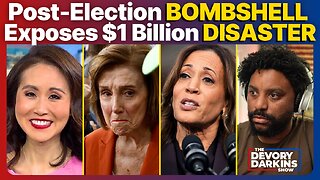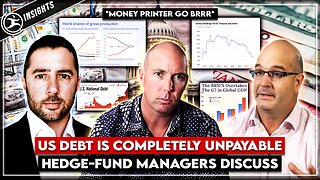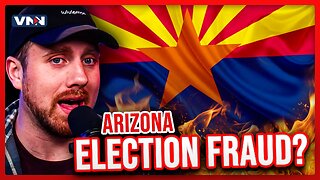Premium Only Content

The Financial Disaster of 2022 | The Gold Standard 2246
https://www.midasgoldgroup.com/
As 2022 winds down, many companies are bracing for market downturns and economic problems in 2023. Global GDP will increase by just 1.7%, the slowest pace of growth in forty years.
The cost-of-living crisis, tightening financial conditions, Putin’s invasions of Ukraine, and lingering ripple effects of the COVID-19 pandemic all contribute to the financial disaster we know as 2022.
The possibility of any soft landing is highly remote. However financially harmful you imagine things can get, it will be worse. In this episode, we discuss how rising interest rates, inflation, bonds, real estate, and the constant printing of money all contribute to building a perfect storm capable of breaking the entire economy.
The US economy is more fragile than it has ever been. Any perception that the nation’s economy is flourishing is using magical thinking. Federal debt continues to rise as politicians increase spending faster than tax revenues can support. Debt weakens our personal and national financial immune systems, and we’ve been in this condition for decades.
Politicians have become increasingly irresponsible. The national budget hasn’t been balanced since 2001, and they have only balanced it 13% of the years since 1930. Both sides of the house are to blame for the mountain of accumulated federal debt, which is about ten times larger than the total state and local government debt. We are about to reap what we have been sowing for decades upon decades of abuse and corruption.
Under more typical economic conditions, the conventional wisdom is to have about 10% of your portfolio in precious metals. Today, the allocation should be more like 20–30%. Gold demonstrates its resilience in adverse and unpredictable environments consistently. There is still time to buy physical gold and silver. Hold precious metals for a while. Keep them in a safe place. No matter what happens, you’ll have peace of mind knowing your wealth is intact.
The paper currency we use today is called Federal Reserve Notes. The official story is that financial assets back these notes that the Federal Reserve Banks pledge as collateral, mainly Treasury securities and mortgage agency securities. One thing is certain. Federal Reserve notes are not based on gold or silver.
Before the Federal Reserve opened its doors in 1914, paper currency was silver and gold certificates. These certificates were a kind of promissory note tied to gold and silver holdings in bank vaults. Banks were obliged to surrender the amount of precious metal specified on the certificate when presented by a holder.
Many corporations are bracing for the coming perfect storm. Major layoffs began last Spring. Carvana, the used car seller, let go of 2,500 employees a week after implementing a hiring freeze. More recently, Goldman Sachs announced plans to lay off more than 400 retail banking positions. The layoffs result from multiple factors, including economic conditions and budget planning for next year. Everyone expects it to make landfall in 2023.
Tech companies report losses in earnings as companies begin to plan for the inevitable. The forecast is dire. These organizations are looking for ways to tighten their belts; cutting workforce reduces overhead quickly. Of course, each laid-off worker will spend less, weakening the economy further. Major layoffs from big companies are only the tip of the iceberg.
1967 saw the introduction of the Gold Krugerrand upon the global market as a way for everyone to own gold. The Krugerrand program was immensely successful. Gold mining snowballed in South Africa, and so did the Rand Refinery. Today, the Rand Refinery is the world’s largest single-site precious metals refinery. By 1980 the Krugerrand accounted for 90% of the world gold market.
Krugerrands gets its name from the former President of the South African Republic and features Otto Schultz’s portrait of South Africa’s four-term President Paul Kruger on the obverse. The reverse shows Court Stenberg’s famous design of the national animal of South Africa, the Springbok.
Gold Krugerrands were the first government bullion coins to reach the global market and are among the most frequently traded gold bullion coins. Another interesting fact about the Krugerrand is that they’re the first coin not to have a denomination inscribed on either side. Perhaps because of their cheaper costs and high liquidity.
The Gold Krugerrand uses a copper-gold alloy for more durability. Because Gold Krugerrands have 22-karat gold at a fineness of .9167%, they are not eligible for Gold IRA programs.
______________________________________________________________________________
Gold IRA: https://www.midasgoldgroup.com/gold-ira/
Invest in Gold: https://www.midasgoldgroup.com/buy-gold/
Guide to Owning Bullion & Coins: https://www.midasgoldgroup.com/bullion-guide/
Read the latest precious metals news: https://www.midasgoldgroup.com/news/
-
 25:06
25:06
Midas Gold Group
3 months agoThe Collapse of FERN (Federal Reserve Note) | The Gold Standard 2428
45 -
 2:49:36
2:49:36
The Jimmy Dore Show
2 days agoRumble Time Live w/ Jimmy Dore & Special Guests Roseanne Barr, Dr. Drew, Drea de Matteo & More!
556K659 -
 17:17
17:17
DeVory Darkins
23 hours agoKamala Post-Election BOMBSHELL Exposes $1 BILLION Campaign DISASTER
84.1K167 -
 19:52
19:52
Stephen Gardner
1 day ago🔥HOLY CRAP! Trump just did the UNTHINKABLE!!
87.4K562 -
 4:34:55
4:34:55
Pepkilla
11 hours agoBlackops Terminus Zombies Boat Glitch
145K7 -
 5:50
5:50
CapEx
23 hours ago $24.71 earnedWhat the Coming & Inevitable Sovereign Debt Crisis Means for YOU | CapEx Insider
130K28 -
 1:34:00
1:34:00
Tactical Advisor
12 hours agoAR15 Giveaway WINNER/Trump Winning | Vault Room Live Stream 008
91.2K42 -
 5:41:10
5:41:10
Vigilant News Network
13 hours agoOfficials CAUGHT Changing Ballots in Arizona | The Daily Dose
140K88 -
 17:30
17:30
Forrest Galante
1 day ago5 Most Dangerous Invasive Species in the World
101K57 -
 38:53
38:53
Popcorn In Bed
1 day agoTOP GUN: MAVERICK | FIRST TIME WATCHING | MOVIE REACTION
111K22